Overview on the Evaluation of the Elastic Properties of Non-Carbon Nanotubes by Theoretical Approaches
Abstract
1. Introduction
2. Atomic Structure of N-CNTs
- zigzag NTs (n, 0) when θ = 0° and m = 0;
- armchair NTs (n, n) when θ = 30° and n = m;
- chiral NTs (n, m) when 0° < θ < 30° and n ≠ m.
3. Analysis of the Literature Results
3.1. Elastic Constants of N-CNTs
3.1.1. Young’s and Shear Moduli
- at first, the Young’s modulus decreases and then becomes almost stable for > 1.5 nm [36];
3.1.2. Poisson’s Ratio
3.2. Vibtational Properties of N-CNTs
4. Conclusions
Author Contributions
Funding
Institutional Review Board Statement
Informed Consent Statement
Data Availability Statement
Conflicts of Interest
References
- Qian, Z.; Hou, S.; Zhang, J.; Li, R.; Shen, Z.; Zhao, X.; Xue, Z. Stability and electronic structure of single-walled InN nanotubes. Physica E 2005, 30, 81–85. [Google Scholar] [CrossRef]
- Ambacher, O. Growth and applications of group III-nitrides. J. Phys. D 1998, 31, 2653–2710. [Google Scholar] [CrossRef]
- Orton, J.W.; Foxon, C.T. Group III nitride semiconductors for short wavelength light-emitting devices. Rep. Prog. Phys. 1998, 61, 1–75. [Google Scholar] [CrossRef]
- Bachtold, A.; Hadley, P.; Nakanishi, T.; Dekker, C. Logic circuits with carbon nanotube transistors. Science 2001, 294, 1317–1320. [Google Scholar] [CrossRef] [PubMed]
- Bhuiyan, A.G.; Hashimoto, A.; Yamamoto, A. Indium nitride (InN): A review ongrowth, characterization, and properties. J. Appl. Phys. 2003, 94, 2779–2808. [Google Scholar] [CrossRef]
- Roudbari, M.A.; Ansari, R. Single-walled boron nitride nanotube as nano-sensor. Contin. Mech. Thermodyn. 2020, 32, 729–748. [Google Scholar] [CrossRef]
- Kong, J.; Franklin, N.R.; Zhou, C.; Chapline, M.G.; Peng, S.; Cho, K.; Dai, H. Nanotube molecular wires as chemical sensors. Science 2000, 287, 622–625. [Google Scholar] [CrossRef]
- Cohen, M.L.; Zettl, A. The physics of boron nitride nanotubes. Phys. Today 2010, 63, 34–38. [Google Scholar] [CrossRef]
- Zhuang, H.L.; Singh, A.K.; Hennig, R.G. Computational discovery of single-layer III–V materials. Phys. Rev. B 2013, 87, 165415–165418. [Google Scholar] [CrossRef]
- Tenne, R. Inorganic Nanotubes and Fullerene-Like Materials. Chem. Eur. J. 2002, 8, 5296–5304. [Google Scholar] [CrossRef]
- Wong, S.; Joselevich, E.; Woolley, A.; Cheung, C.; Lieber, C.M. Covalently functionalized nanotubes as nanometre- sized probes in chemistry and biology. Nature 1998, 394, 52–55. [Google Scholar] [CrossRef]
- Chopra, N.G.; Luyken, R.J.; Cherrey, K.; Crespi, V.H.; Cohen, M.L.; Louie, S.G.; Zettl, A. Boron nitride nanotubes. Science 1995, 269, 966–967. [Google Scholar] [CrossRef]
- Fan, Y. Formation of crystalline AlN nanotubes by a roll-up approach. Mater. Lett. 2011, 65, 1900–1902. [Google Scholar] [CrossRef]
- Wu, Q.; Hu, Z.; Wang, X.; Lu, Y.; Chen, X.; Xu, H.; Chen, Y. Synthesis and characterization of faceted hexagonal aluminum nitride nanotubes. J. Am. Chem. Soc. 2003, 125, 10176–10177. [Google Scholar] [CrossRef]
- Stan, G.; Ciobanu, C.V.; Thayer, T.P.; Wang, G.T.; Creighton, J.R.; Purushotham, K.P.; Bendersky, L.A.; Cook, R.F. Elastic moduli of faceted aluminum nitride nanotubes measured by contact resonance atomic force microscopy. Nanotechnology 2009, 20, 035706. [Google Scholar] [CrossRef][Green Version]
- Hung, S.C.; Su, Y.K.; Fang, T.H.; Chang, S.J.; Ji, L.W. Buckling instabilities in GaN nanotubes under uniaxial compression. Nanotechnology 2005, 16, 2203–2208. [Google Scholar] [CrossRef]
- Goldberger, J.; He, R.; Zhang, Y.; Lee, S.; Yan, H.; Choi, H.-J.; Peidong, Y. Single-crystal gallium nitride nanotubes. Nature 2003, 422, 599–602. [Google Scholar] [CrossRef]
- Wu, Q.; Hu, Z.; Liu, C.; Wang, X.; Chen, Y.; Lu, Y. Synthesis and optical properties of gallium phosphide nanotubes. J. Phys. Chem. B 2005, 109, 19719–19722. [Google Scholar] [CrossRef]
- Bakkers, E.P.A.M.; Verheijen, M.A. Synthesis of InP Nanotubes. J. Am. Chem. Soc. 2003, 125, 3440–3441. [Google Scholar] [CrossRef]
- Sun, X.H.; Li, C.P.; Wong, W.K.; Wong, N.B.; Lee, C.S.; Lee, S.T.; Teo, B.K. Formation of silicon carbide nanotubes and nanowires via reaction of silicon (from disproportionation of silicon monoxide) with carbon nanotubes. J. Am. Chem. Soc. 2002, 124, 14464–14471. [Google Scholar] [CrossRef]
- Peng, Q.; Sun, X.; Wang, H.; Yang, Y.; Wene, X.; Huang, C.; Liu, S.; De, S. Theoretical prediction of a graphene-like structure of indium nitride: A promising excellent material for optoelectronics. Appl. Mater. Today 2017, 7, 169–178. [Google Scholar] [CrossRef]
- Mirzaei, M.; Giahi, M. Computational studies on boron nitride and boron phosphide nanotubes: Density functional calculations of boron-11 electric field gradient tensors. Physica E 2010, 42, 1667–1669. [Google Scholar] [CrossRef]
- Mirzaei, M.; Meskinfam, M. Computational studies of effects of tubular lengths on the NMR properties of pristine and carbon decorated boron phosphide nanotubes. Solid State Sci. 2011, 13, 1926–1930. [Google Scholar] [CrossRef]
- Mirzaei, M.; Mirzaei, M. Aluminum phosphide nanotubes: Density functional calculations of aluminum-27 and phosphorus-31 chemical shielding parameters. J. Mol. Struct. Theochem. 2010, 951, 69–71. [Google Scholar] [CrossRef]
- Erkoç, S. Semi-empirical SCF-MO calculations for the structural and electronic properties of single-wall InP nanotubes. J. Mol. Struct. Theochem. 2004, 676, 109–113. [Google Scholar] [CrossRef]
- Mirzaei, M.; Mirzaei, M. A computational study of gallium phosphide nanotubes. Physica E 2011, 43, 1343–1345. [Google Scholar] [CrossRef]
- Mirzaei, M.; Yousefi, M.; Meskinfam, M. Studying (n, 0) and (m,m) GaP nanotubes (n = 3−10 and m = 2−6) through DFT calculations of Ga-69 quadrupole coupling constants. Solid State Sci. 2012, 14, 801–804. [Google Scholar] [CrossRef]
- Guo, Y.; Yan, X.; Yang, Y. First-principles study of narrow single-walled GaN nanotubes. Phys. Lett. A 2009, 373, 367–370. [Google Scholar] [CrossRef]
- Pinal, G.B.; Marana, N.L.; Fabris, G.S.L.; Sambrano, J.R. Structural, electronic and mechanical properties of single-walled AlN and GaN nanotubes via DFT/B3LYP. Theor. Chem. Acc. 2019, 138, 1–11. [Google Scholar] [CrossRef]
- Marana, N.L.; Pinhal, G.B.; Laranjeira, J.A.S.; Buzolin, P.G.C.; Longo, E.; Sambrano, J.R. Strain-induced novel properties of alloy nitride nanotubes. Comput. Mater. Sci. 2020, 177, 109589–109598. [Google Scholar] [CrossRef]
- Choyal, V.K.; Choyal, V.; Nevhal, S.; Bergaley, A.; Kundalwal, S.I. Effect of aspects ratio on Young’s modulus of boron nitride nanotubes: A molecular dynamics study the continuum mechanics. Mater. Today Proc. 2020, 26, 1–4. [Google Scholar] [CrossRef]
- Ansari, R.; Rouhi, S.; Mirnezhad, M.; Aryayi, M. Stability characteristics of single-walled boron nitride nanotubes. Arch. Civ. Mech. Eng. 2015, 15, 162–170. [Google Scholar] [CrossRef]
- Jiang, L.; Guo, W. A molecular mechanics study on size-dependent elastic properties of single-walled boron nitride nanotubes. J. Mech. Phys. Solids 2011, 59, 1204–1213. [Google Scholar] [CrossRef]
- Li, C.; Chou, T.W. Static and dynamic properties of single-walled boron nitride nanotubes. J. Nanosci. Nanotechnol. 2006, 6, 54–60. [Google Scholar] [CrossRef]
- Vijayaraghavan, V.; Zhang, L. Consistent computational modeling of mechanical properties of carbon and boron nitride nanotubes. JOM 2020, 72, 3968–3976. [Google Scholar] [CrossRef]
- Sakharova, N.A.; Antunes, J.M.; Pereira, A.F.G.; Chaparro, B.M.; Fernandes, J.V. On the determination of elastic properties of single-walled boron nitride nanotubes by numerical simulation. Materials 2021, 14, 3183–3210. [Google Scholar] [CrossRef]
- Kochaev, A. Elastic properties of noncarbon nanotubes as compared to carbon nanotubes. Phys. Rev. B 2017, 96, 155428–155435. [Google Scholar] [CrossRef]
- Jeng, Y.R.; Tsai, P.C.; Fang, T.H. Molecular dynamics investigation of the mechanical properties of gallium nitride nanotubes under tension and fatigue. Nanotechnology 2004, 15, 1737–1744. [Google Scholar] [CrossRef]
- Jiang, L.; Guo, W. Analytical solutions for elastic binary nanotubes of arbitrary chirality. Acta Mech. Sin. 2016, 32, 1046–1057. [Google Scholar] [CrossRef]
- Kang, J.W.; Hwang, H.J. Atomistic study of III-nitride nanotubes. Comput. Mater. Sci. 2004, 31, 237–246. [Google Scholar] [CrossRef]
- Genoese, A.; Genoese, A.; Salerno, G. On the nanoscale behaviour of single-wall C, BN and SiC nanotubes. Acta Mech. 2019, 230, 1105–1128. [Google Scholar] [CrossRef]
- Mercan, K.; Civalek, O. Buckling analysis of Silicon carbide nanotubes (SiCNTs) with surface effect and nonlocal elasticity using the method of HDQ. Comp. Part B Eng. 2017, 114, 34–45. [Google Scholar] [CrossRef]
- Le, M.Q. Young’s modulus prediction of hexagonal nanosheets and nanotubes based on dimensional analysis and atomistic simulations. Meccanica 2014, 49, 1709–1719. [Google Scholar] [CrossRef]
- Sakharova, N.A.; Antunes, J.M.; Pereira, A.F.G.; Fernandes, J.V. Developments in the evaluation of elastic properties of carbon nanotubes and their heterojunctions by numerical simulation. AIMS Mater. Sci. 2017, 4, 706–737. [Google Scholar] [CrossRef]
- Rafiee, R.; Moghadam, R.M. On the modelling of carbon nanotubes: A critical review. Compos. Part B Eng. 2014, 56, 435–449. [Google Scholar] [CrossRef]
- Baumeier, B.; Kruger, P.; Pollmann, J. Structural, elastic, and electronic properties of SiC, BN, and BeO nanotubes. Phys. Rev. B 2007, 76, 85407–85417. [Google Scholar] [CrossRef]
- Hao, J.H.; Wang, Y.F.; Yin, Y.H.; Jiang, R.; Wang, Y.F.; Jin, Q.H. An ab initio study of the size-dependent mechanical behavior of single-walled AlN nanotubes. Solid State Sci. 2015, 45, 30–34. [Google Scholar] [CrossRef]
- Chandra, A.; Patra, P.K.; Bhattacharya, B. Thermal vibration characteristics of armchair boron-nitride nanotubes. J. Appl. Phys. 2015, 118, 234503–234508. [Google Scholar] [CrossRef]
- Jeng, Y.R.; Tsai, P.C.; Fang, T.H. Tensile deformation of tubular structures of nitride-based nanotubes: Brittle and weak behavior. Tamkang J. Sci. Eng. 2005, 8, 191–195. [Google Scholar]
- Xiong, Q.; Tian, X.G. Torsional properties of hexagonal boron nitride nanotubes, carbon nanotubes and their hybrid structures: A molecular dynamics study. AIP Adv. 2015, 5, 107215–107227. [Google Scholar] [CrossRef]
- Moon, W.H.; Ham, J.K.; Hwang, H.J. Mechanical properties of SiC nanotubes. In In Technical Proceedings of the 2003 Nanotechnology Conference and Trade Show, San Francisco, CA, USA, 23–27 February 2003. [Google Scholar]
- Setoodeh, A.R.; Jahanshahi, M.; Attariani, H. Atomistic simulations of the buckling behavior of perfect and defective silicon carbide nanotubes. Comput. Mater. Sci. 2009, 47, 388–397. [Google Scholar] [CrossRef]
- Pan, H.; Si, X. Molecular dynamics simulations of diameter dependence tensile behavior of silicon carbide nanotubes. Physica B 2009, 404, 1809–1812. [Google Scholar] [CrossRef]
- Zhou, R.L.; Wang, L.; Pan, B.C. Elastic and Melting Properties of Crystalline SiC Nanotubes. J. Phys. Chem. C 2010, 114, 8199–8205. [Google Scholar] [CrossRef]
- Verma, V.; Jindal, V.K.; Dharamvir, K. Elastic moduli of a boron nitride nanotube. Nanotechnology. 2007, 18, 435711–435717. [Google Scholar] [CrossRef]
- Tao, J.; Xu, G.; Sun, Y. Elastic properties of boron-nitride nanotubes through an atomic simulation method. Math. Prob. Eng. 2015, 2015, 240547. [Google Scholar] [CrossRef]
- Ansari, R.; Ajori, S. A molecular dynamics study on the vibration of carbon and boron nitride double-walled hybrid nanotubes. Appl. Phys. A 2015, 120, 1399–1406. [Google Scholar] [CrossRef]
- Wang, Z.; Zu, X.; Gao, F.; Weber, W.J. Mechanical behavior of gallium nitride nanotubes under combined tension-torsion: An atomistic simulation. J. Appl. Phys. 2008, 103, 13505–13509. [Google Scholar] [CrossRef]
- Santosh, M.; Maiti, P.K.; Sood, A.K. Elastic properties of boron nitride nanotubes and their comparison with carbon nanotubes. J. Nanosci. Nanotechnol. 2009, 9, 1–6. [Google Scholar] [CrossRef]
- Hernandez, E.; Goze, C.; Bernier, P.; Rubio, A. Elastic properties of C and BxCyNz composite nanotubes. Phys. Rev. Lett. 1998, 80, 4502–4505. [Google Scholar] [CrossRef]
- Zhang, D.B.; Akatyeva, E.; Dumitrica, T. Helical BN and ZnO nanotubes with intrinsic twisting: An objective molecular dynamics study. Phys. Rev. B 2011, 84, 115431–115438. [Google Scholar] [CrossRef]
- Oh, E.S. Elastic properties of boron-nitride nanotubes through the continuum lattice approach. Mater. Lett. 2010, 64, 859–862. [Google Scholar] [CrossRef]
- Panchal, M.B.; Upadhyay, S.H.; Harsha, S.P. Vibration analysis of single walled boron nitride nanotube based nanoresonators. J. Nanotechnol. Eng. Med. 2012, 3, 31004–31009. [Google Scholar] [CrossRef]
- Song, J.; Wu, J.; Huang, Y.; Hwang, K.C. Continuum modeling of boron nitride nanotubes. Nanotechnol. 2008, 19, 445705–445715. [Google Scholar] [CrossRef]
- Salavati, M.; Ghasemi, H.; Rabczuk, T. Electromechanical properties of boron nitride nanotube: Atomistic bond potential and equivalent mechanical energy approach. Comp. Mater. Sci. 2018, 149, 460–465. [Google Scholar] [CrossRef]
- Ansari, R.; Mirnezhad, M.; Sahmani, S. Prediction of chirality- and size-dependent elastic properties of single-walled boron nitride nanotubes based on an accurate molecular mechanics model. Superlattice Microst. 2015, 80, 196–205. [Google Scholar] [CrossRef]
- Panchal, M.B.; Upadhyay, S.H.; Harsha, S.P. An efficient finite element model for analysis of single walled boron nitride nanotube-based resonant nanomechanical sensors. NANO Brief Rep. Rev. 2013, 8, 1350011–1350027. [Google Scholar] [CrossRef]
- Zakaria, A.Z. A two-section beam element to model the B-N covalent bonds in boron nitride nanotubes. Mater. Res. Bull. 2022, 145, 111533–111540. [Google Scholar] [CrossRef]
- Giannopoulos, G.I.; Kontoni, D.-P.N.; Georgantzinos, S.K. Efficient FEM simulation of static and free vibration behaviour of single walled boron nitride nanotubes. Superlattice Microst. 2016, 96, 111–120. [Google Scholar] [CrossRef]
- Yan, J.W.; Liew, K.M. Predicting elastic properties of single-walled boron nitride nanotubes and nanocones using an atomistic-continuum approach. Compos. Struct. 2015, 125, 489–498. [Google Scholar] [CrossRef]
- Yan, J.W.; He, J.B.; Tong, L.H. Longitudinal and torsional vibration characteristics of boron nitride nanotubes. J. Vib. Eng. Technol. 2019, 7, 205–215. [Google Scholar] [CrossRef]
- Rappé, A.K.; Casewit, C.J.; Colwell, K.S.; Goddard, W.A.; Skid, W.M. UFF, a full periodic table force field for molecular mechanics and molecular dynamics simulations. J. Am. Chem. Soc. 1992, 114, 10024–10039. [Google Scholar] [CrossRef]
- Mayo, S.L.; Barry, D.; Olafson, B.D.; Goddard, W.A. DREIDING: A generic force field for molecular simulations. J. Phys. Chem. 1990, 94, 8897–8909. [Google Scholar] [CrossRef]
- Arenal, R.; Wang, M.S.; Xu, Z.; Loiseau, A.; Golberg, D. Young modulus, mechanical and electrical properties of isolated individual and bundled single-walled boron nitride nanotubes. Nanotechnology 2011, 22, 265704–265710. [Google Scholar] [CrossRef]
- Chopra, N.G.; Zettl, A. Measurement of the elastic modulus of a multi-wall boron nitride nanotube. Solid State Commun. 1998, 105, 297–300. [Google Scholar] [CrossRef]
- Suryavanshi, A.P.; Yu, M.F.; Wen, J.; Tang, C.; Bando, Y. Elastic modulus and resonance behavior of boron nitride nanotubes. Appl. Phys. Lett. 2004, 84, 2527–2529. [Google Scholar] [CrossRef]
- Golberg, D.; Costa, P.M.F.J.; Lourie, O.; Mitome, M.; Bai, X.; Kurashima, K.; Zhi, C.; Tang, C.; Bando, Y. Direct force measurements and kinking under elastic deformation of individual multiwalled boron nitride nanotubes. Nano Lett. 2007, 7, 2146–2151. [Google Scholar] [CrossRef]
- Ghassemi, H.M.; Lee, C.H.; Yap, Y.K.; Yassar, R.S. Real-time fracture detection of individual boron nitride nanotubes in severe cyclic deformation processes. J. Appl. Phys. 2010, 108, 24314–24318. [Google Scholar] [CrossRef]
- Tanur, A.E.; Wang, J.; Reddy, A.L.M.; Lamont, D.N.; Yap, Y.K.; Walker, G.C. Diameter-dependent bending modulus of individual multiwall boron nitride nanotubes. J. Phys. Chem. B 2013, 117, 4618–4625. [Google Scholar] [CrossRef]
- Zhou, X.; Tang, D.-M.; Mitome, M.; Bando, Y.; Sasaki, T.; Golberg, D. Intrinsic and defect-related elastic moduli of boron nitride nanotubes as revealed by in situ Transmission Electron Microscopy. Nano Lett. 2019, 19, 4974–4980. [Google Scholar] [CrossRef]
- Chen, G.; Lu, H.; Cui, J.; Yu, H.; Wang, B.; Liu, Y.; Li, H.; Jiang, N. In situ real-time study buckling behavior of boron nitride nanotubes with axial compression by TEM. Chin. Chem. Lett. 2019, 30, 1401–1404. [Google Scholar] [CrossRef]
- Hung, S.C.; Su, Y.K.; Fang, T.H.; Liang, T.C. Elastic modulus investigation of gallium nitride nanotubes. In Proceedings of the 1st IEEE International Conference on Nano/Micro Engineered and Molecular Systems, Zhuhai, China, 18–21 January 2006. [Google Scholar]
- Tapia, A.; Cab, C.; Hernández-Pérez, A.; Villanueva, C.; Peñuñuri, F.; Avilés, F. The bond force constants and elastic properties of boron nitride nanosheets and nanoribbons using a hierarchical modeling approach. Physica E 2017, 89, 183–193. [Google Scholar] [CrossRef]
- Şahin, H.; Cahangirov, S.; Topsakal, M.; Bekaroglu, E.; Akturk, E.; Senger, R.T.; Ciraci, S. Monolayer honeycomb structures of group-IV elements and III-V binary compounds: First-principles calculations. Phys. Rev. B 2009, 80, 155453–155465. [Google Scholar] [CrossRef]
- Menon, M.; Srivastava, D. Structure of boron nitride nanotubes: Tube closing versus chirality. Chem. Phys. Lett. 1999, 307, 407–412. [Google Scholar] [CrossRef]
- Huber, K.P.; Hertzberg, G. Molecular Spectra and Molecular Siructure: IV. Constants of Diatomic Molecules, 1st ed.; Van Nostrand Reinhold Company: New York, NY, USA, 1979. [Google Scholar]
- Zhou, Z.; Zhao, J.; Chen, Y.; Schleyer, P.R.; Chen, Z. Energetics and electronic structures of AlN nanotubes/wires and their potential application as ammonia sensors. Nanotechnology 2007, 18, 424023–424030. [Google Scholar] [CrossRef]
- Lee, S.M.; Lee, Y.H.; Hwang, Y.G.; Elsner, J.; Porezag, D.; Frauenheim, T. Stability and electronic structure of GaN nanotubes from density-functional calculations. Phys. Rev. B 1999, 60, 7788–7792. [Google Scholar] [CrossRef]
- Lisenkov, S.V.; Vinogradov, G.A.; Lebedev, N.G. New class of non-carbon AlP nanotubes: Structure and electronic properties. J. Exp. Theor. Phys. Lett. 2005, 81, 185–189. [Google Scholar] [CrossRef]
- Mirzaei, M.; Mirzaei, M. DFT calculations of NMR properties for GaP nanotubes. Monatsh. Chem. 2011, 142, 111–114. [Google Scholar] [CrossRef]
- Chowdhury, R.; Adhikari, S. Boron-nitride nanotubes as zeptogram-scale bionanosensors: Theoretical investigations. IEEE Trans. Nanotechnol. 2011, 10, 659–667. [Google Scholar] [CrossRef]
- Shannon, M.A.; Bohn, P.W.; Elimelech, M.; Georgiadis, J.G.; Marinas, B.J.; Mayes, A.M. Science and technology for water purification in the coming decades. Nature 2008, 452, 301–310. [Google Scholar] [CrossRef]
- Zhao, M.; Xia, Y.; Li, F.; Zhang, R.Q.; Lee, S.T. Strain energy and electronic structures of silicon carbide nanotubes: Density functional calculations. Phys. Rev. B 2005, 71, 85312–85318. [Google Scholar] [CrossRef]
- Alam, K.M.; Ray, A.K. Hybrid density functional study of armchair SiC nanotubes. Phys. Rev. B 2008, 77, 35436–35446. [Google Scholar] [CrossRef]
- Pelesko, J.A.; Bernstein, D.H. Modeling MEMS and NEMS, 1st ed.; Chapman & Hal/CRC: Boca Raton, FL, USA, 2002. [Google Scholar]
- Ekinci, K.L. Electromechanical transducers at the nanoscale: Actuation and sensing of motion in Nanoelectromechanical Systems (NEMS). Small 2005, 1, 786–797. [Google Scholar] [CrossRef]
- Peng, H.B.; Chang, C.W.; Aloni, S.; Yuzvinsky, T.D.; Zettl, A. Ultrahigh frequency nanotube resonators. Phys. Rev. Lett. 2006, 97, 87203–87207. [Google Scholar] [CrossRef]
- Chowdhury, R.; Wang, C.Y.; Adhikari, S.; Scarpa, F. Vibration and symmetry-breaking of boron nitride nanotubes. Nanotechnolohy 2010, 21, 365702–365711. [Google Scholar] [CrossRef]
- Panchal, M.B.; Upadhyay, S.H. Single walled boron nitride nanotube-based biosensor: An atomistic finite element modelling approach. IET Nanobiotechnol. 2014, 8, 149–156. [Google Scholar] [CrossRef]
- Khani, N.; Fakhrabadi, M.M.S.; Vahabi, M.; Kamkari, B. Modal analysis of silicon carbide nanotubes using structural mechanics. Appl. Phys. A 2014, 116, 1687–1694. [Google Scholar] [CrossRef]
- Ansari, R.; Rouhi, S. Vibrational analysis of single-layered silicon carbide nanosheets and single-walled silicon carbide nanotubes using nanoscale finite element method. Proc. Inst. Mech. Eng. C J. Mech. Eng. Sci. 2017, 231, 3455–3461. [Google Scholar] [CrossRef]
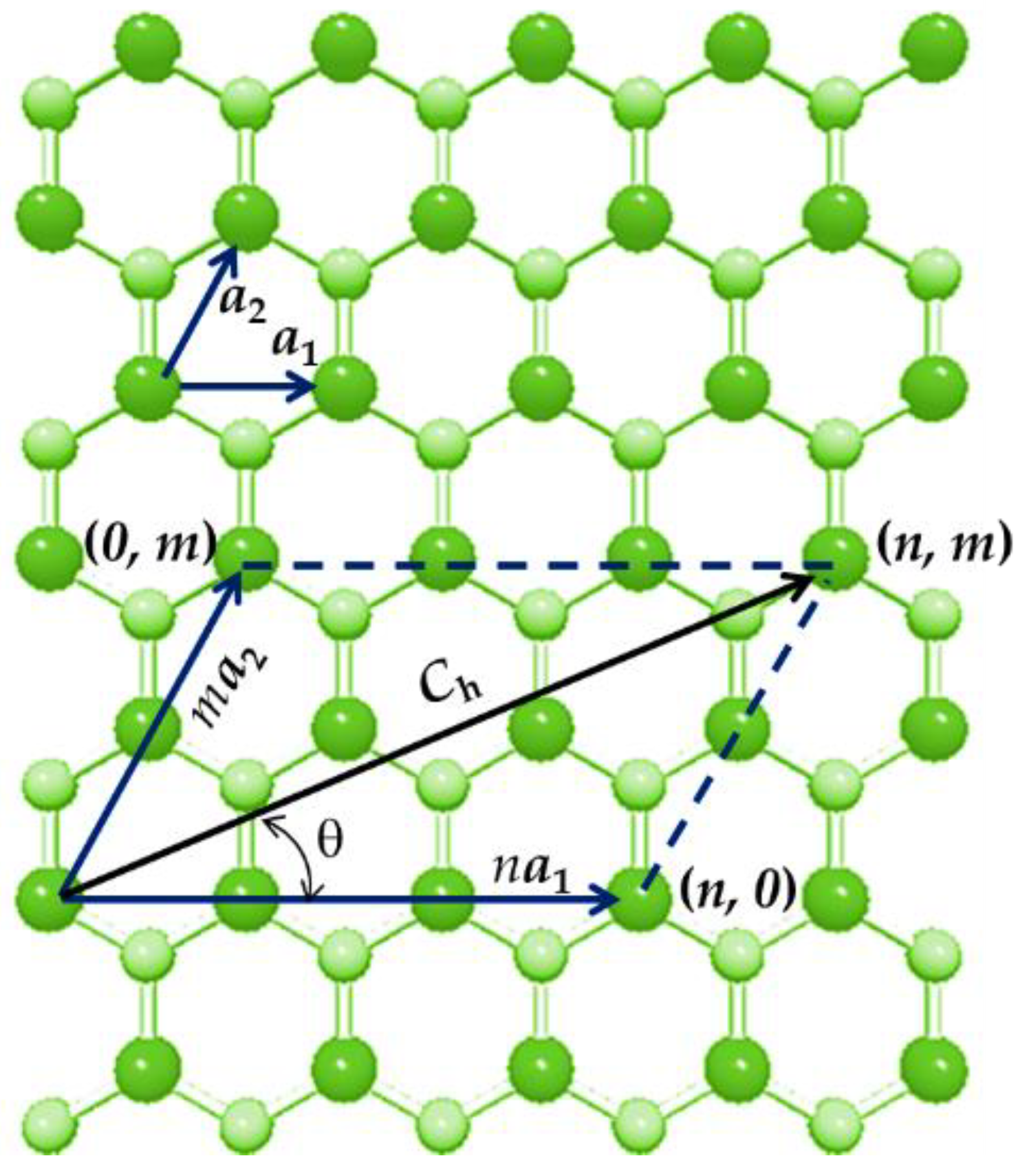



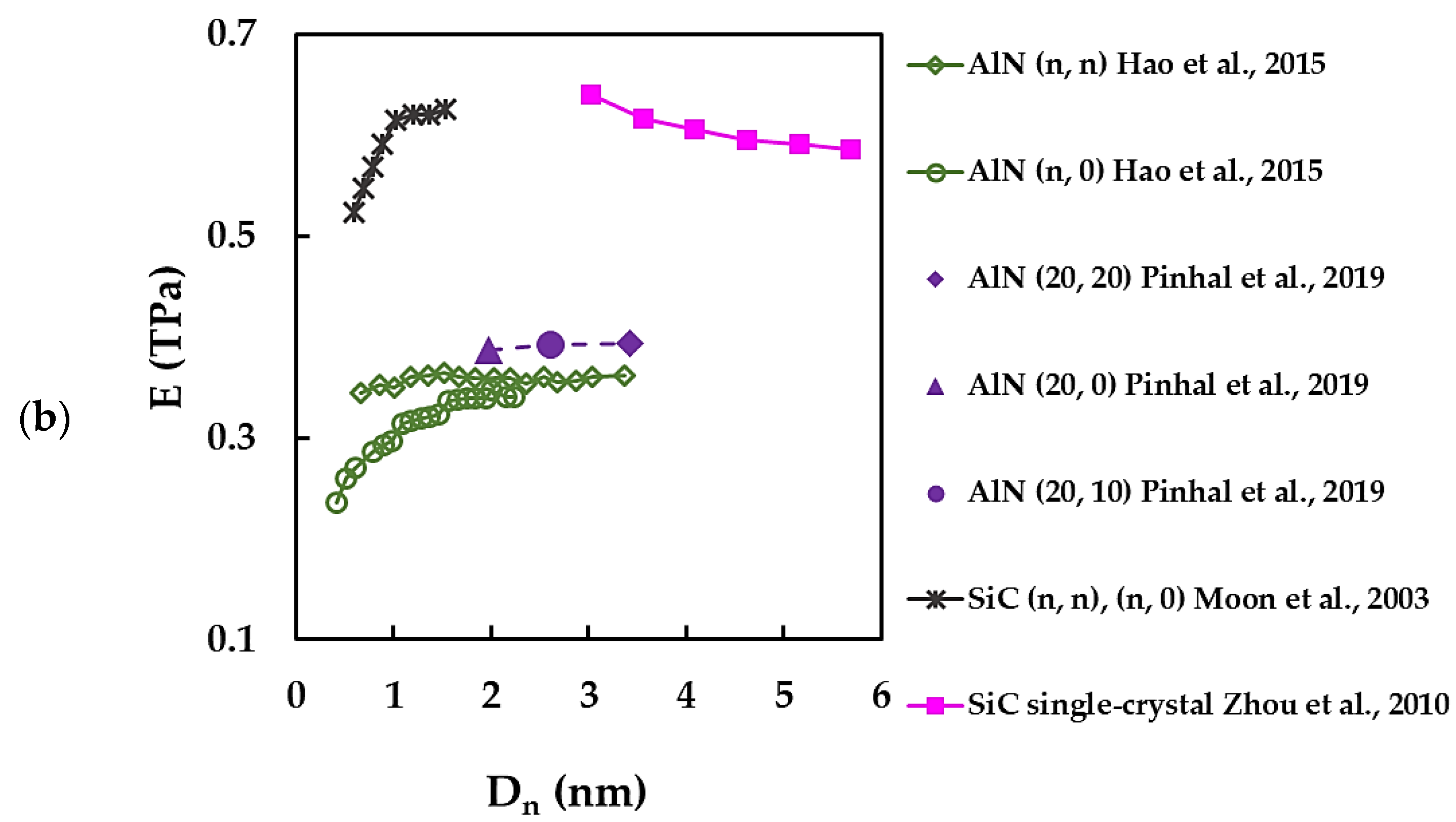
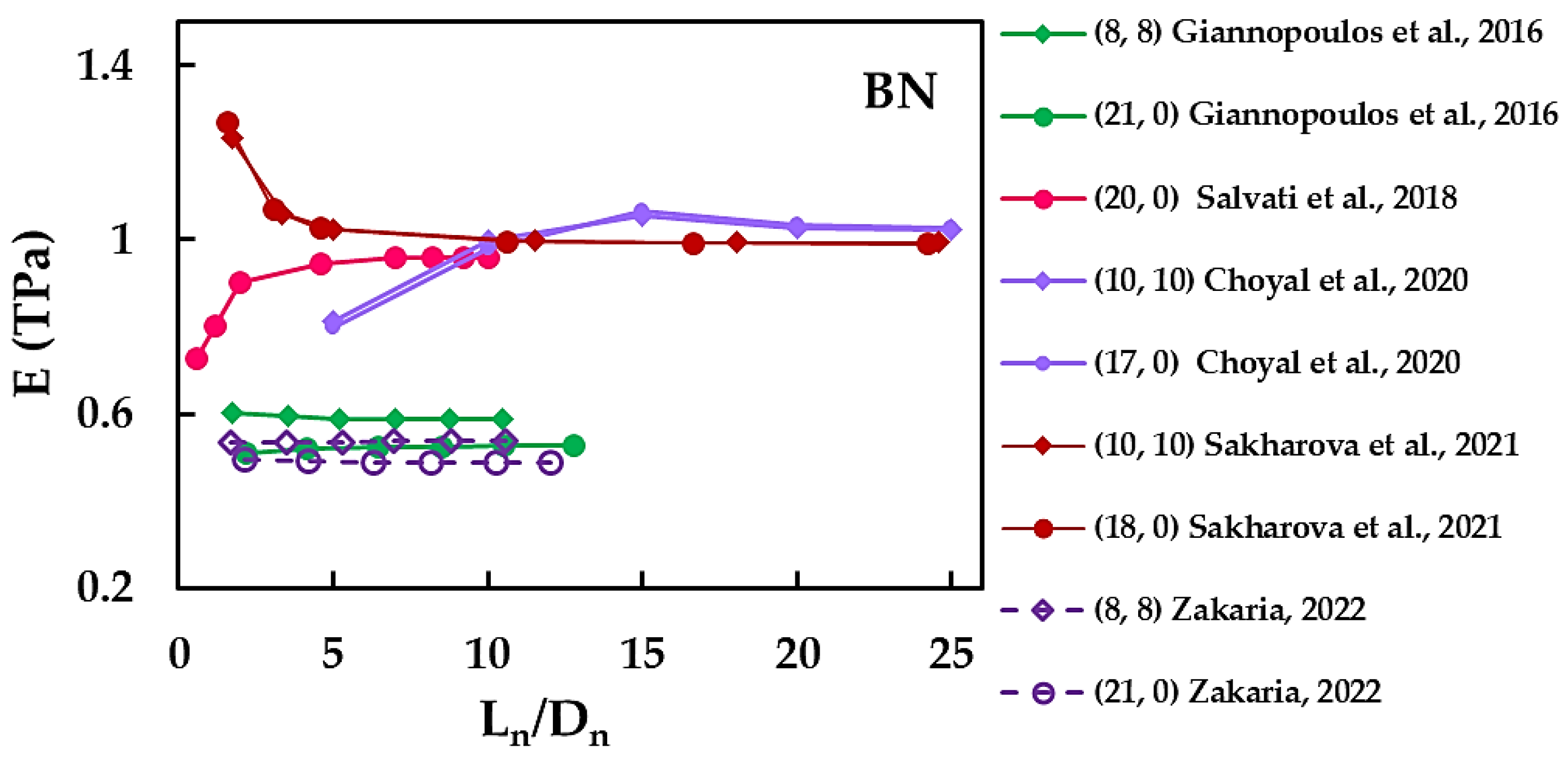

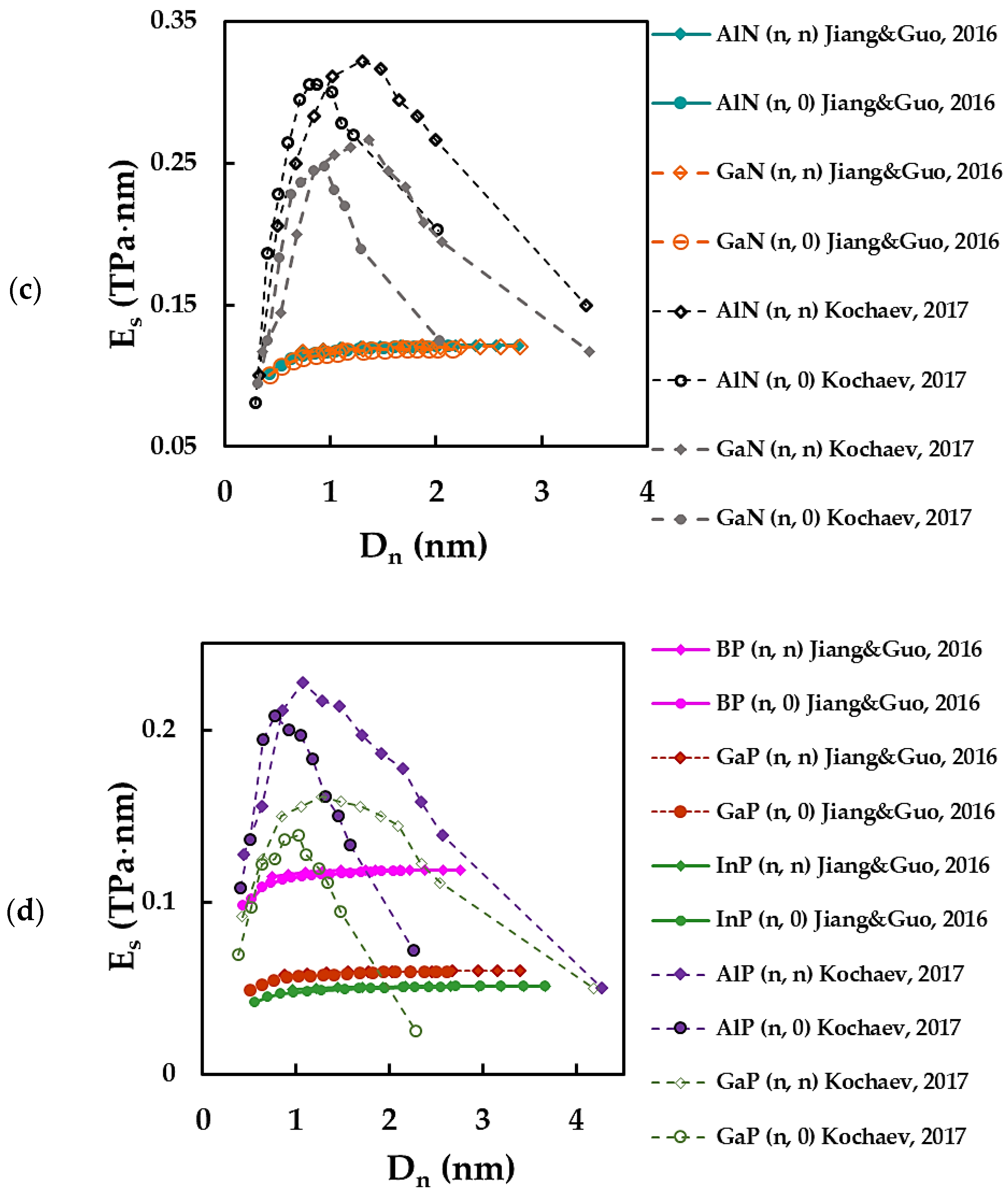
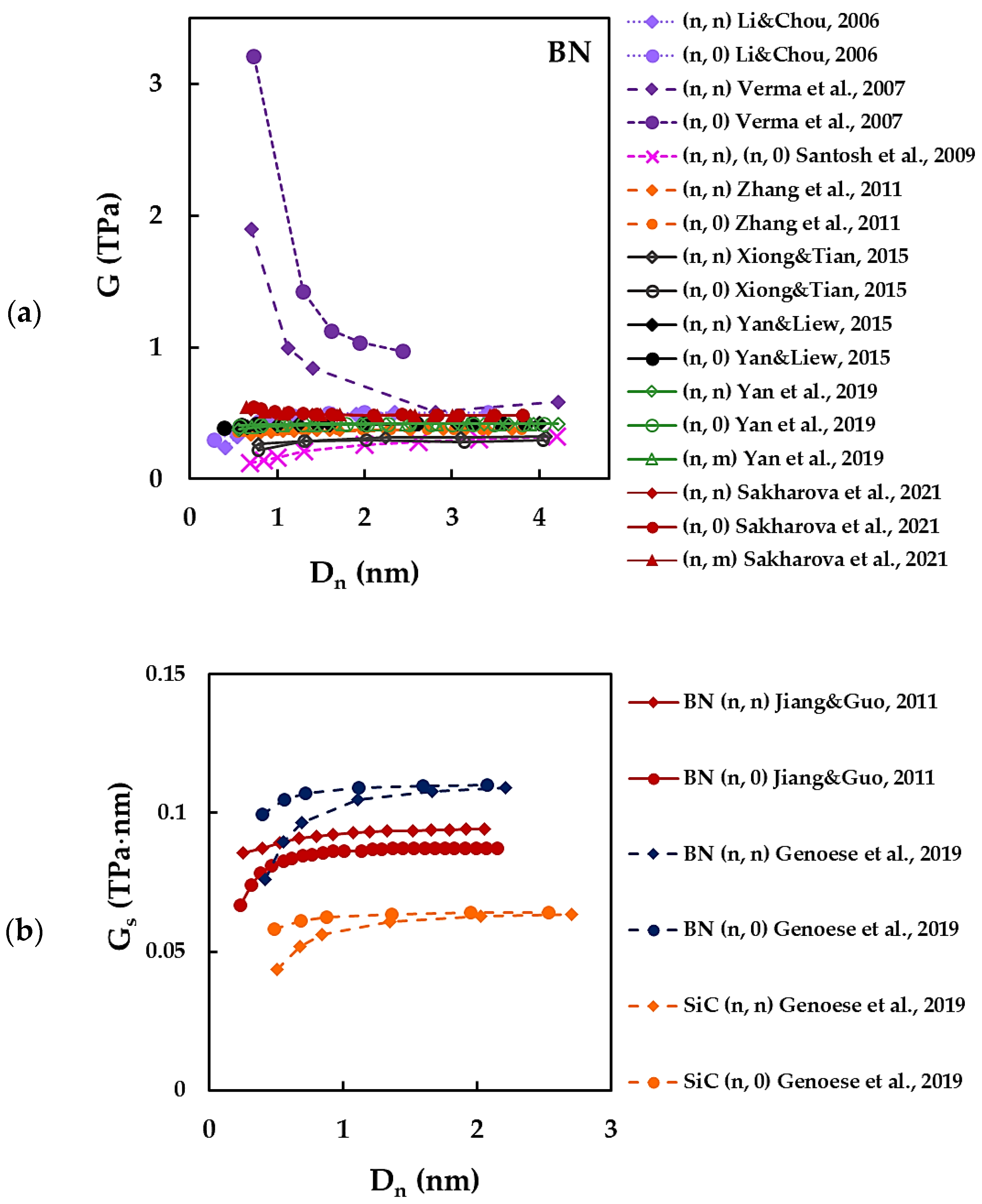

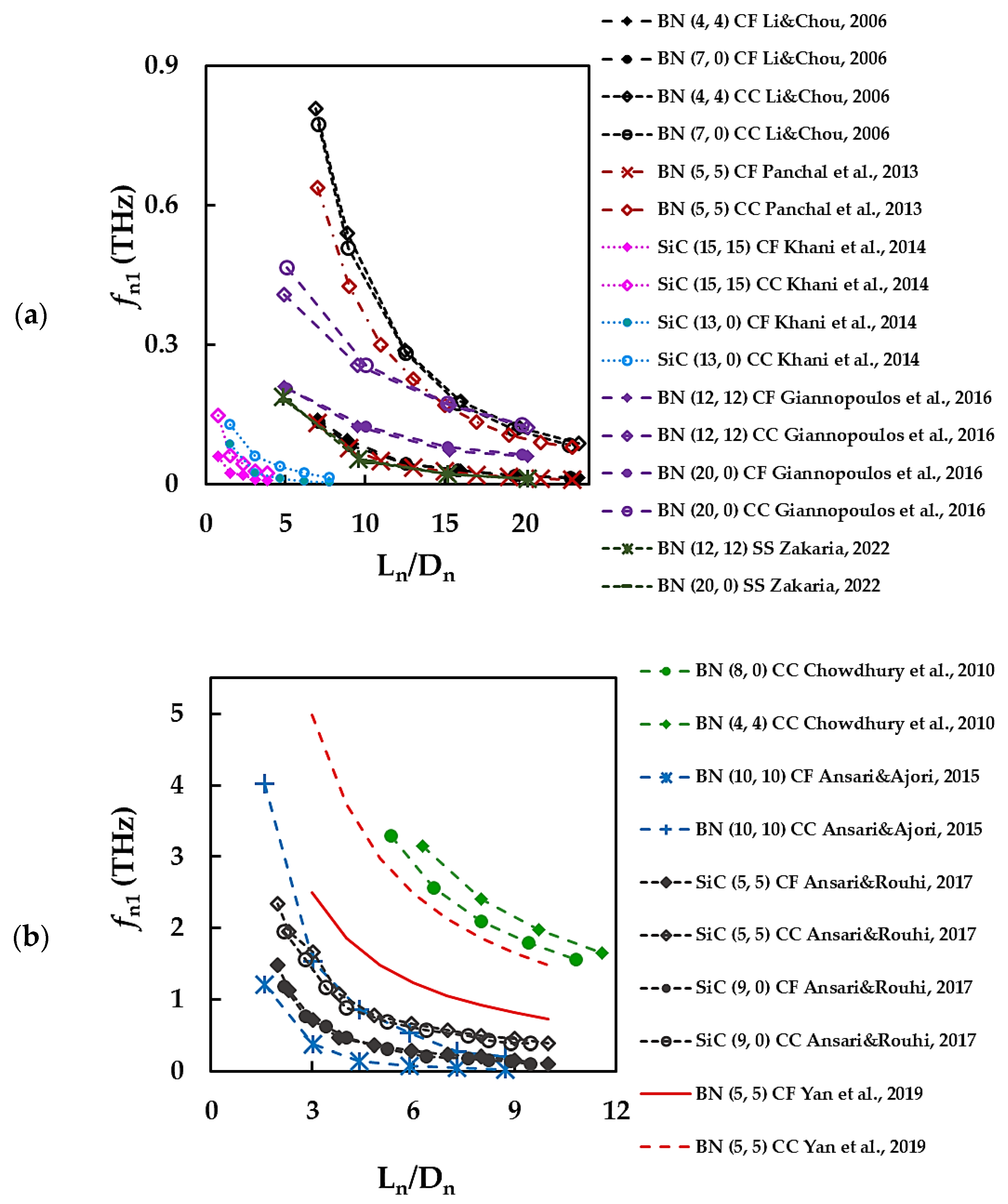
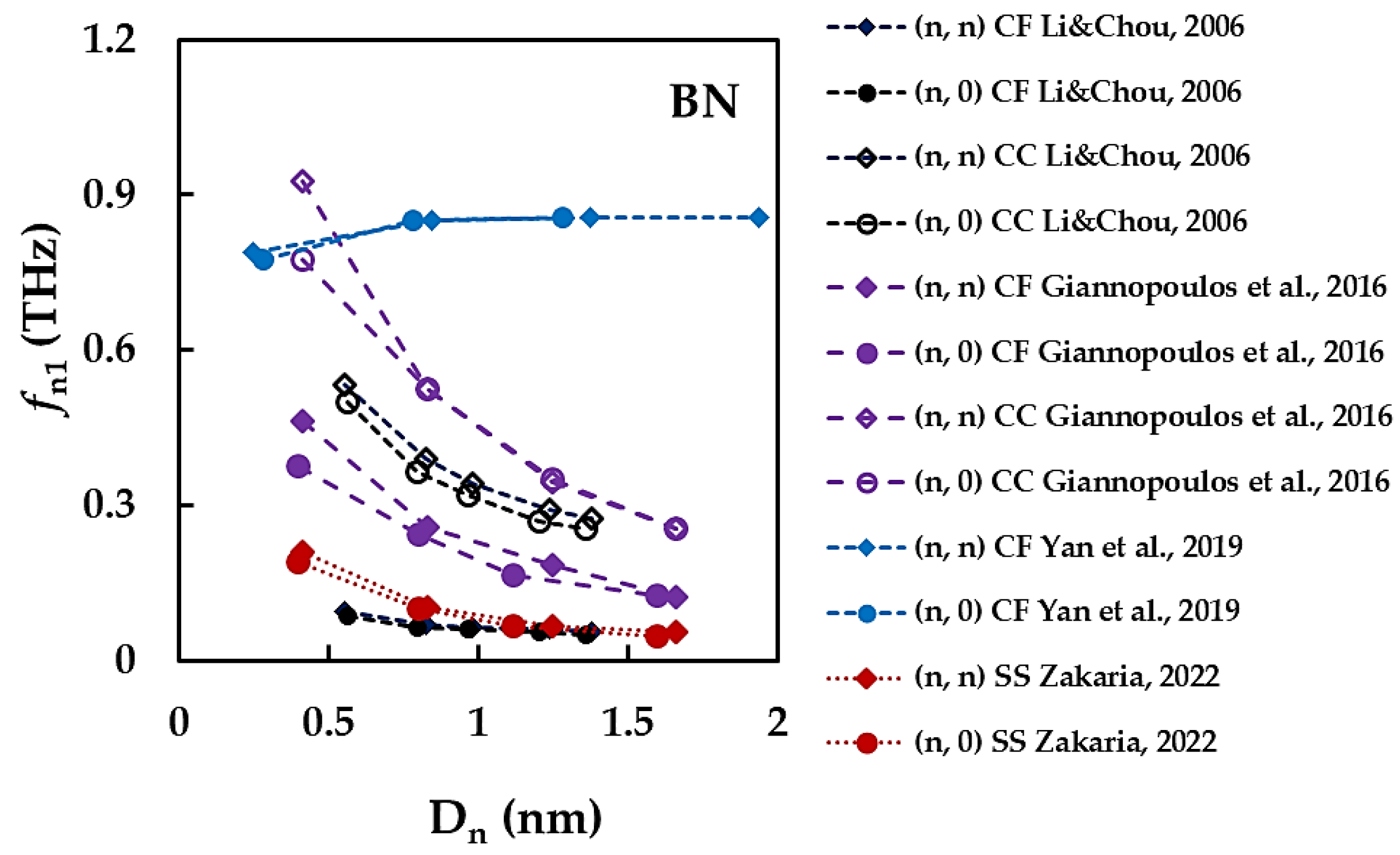
| Compound | BN | AlN | GaN | InN | BP | AlP | GaP | InP | SiC |
|---|---|---|---|---|---|---|---|---|---|
| aA1–A2, nm | 0.1447 [83] 0.145 [84] 0.147 [37] 0.151 [85] 0.153 [33] | 0.177 [37] 0.179 [84] 0.185 [40] 0.193 [86] 0.195 [87] | 0.175 [88] 0.184 [37] 0.185 [84] 0.186 [40] 0.194 [86] | 0.203 [1] 0.206 [84] | 0.183 [84] 0.193 [86] | 0.234 [89] 0.240 [37] | 0.220 [37] 0.225 [84] 0.229 [90] 0.236 [86] | 0.246 [84] 0.256 [86] | 0.177 [84] 0.179 [51] 0.185 [86] |
| Approach | Year | Reference | Method | Type of NTs 1 | E, TPa 2 | Es, TPa⋅nm | G, TPa 2 | Gs, TPa⋅nm | Comment | |
|---|---|---|---|---|---|---|---|---|---|---|
| Atomistic | 1998 | Hernandez et al. [60] | TBMD | BN | (n, n) | 0.894 | – | – | – | average value |
| (n, 0) | 0.896 | |||||||||
| 2003 | Moon et al. [51] | MD: Tersoff empirical potential | SiC | (n, n) | 0.621 | – | – | – | average value | |
| (n, 0) | 0.558 | |||||||||
| 2004 | Jeng et al. [38] | MD: TB many body potential | GaN | (5, 5) | 0.793 | – | – | – | – | |
| (9, 0) | 0.721 | |||||||||
| 2004 | Kang and Hwang [40] | MD: Tersoff-type potential | BN | (5, 5) | 0.870 | – | – | – | – | |
| AlN | 0.453 | |||||||||
| GaN | 0.796 | |||||||||
| 2007 | Baumeier et al. [46] | ab initio: DFT-SIC | BN | (n, n) | – | 0.278 | – | – | converged average value | |
| (n, 0) | 0.272 | |||||||||
| SiC | (n, n) | 0.167 | ||||||||
| (n, 0) | 0.162 | |||||||||
| 2007 | Verma et al. [55] | MD: TB potential | BN | (n, n) | 1.107 | – | 0.965 | – | average value | |
| (n, 0) | 1.044 | 1.555 | ||||||||
| 2009 | Santosh et al. [59] | MD: force—constant approach | BN | (n, n); (n, 0) | 1.017 | – | 0.326 | – | converged average value | |
| 2009 | Setoodeh et al. [52] | MD: Tersoff potential | SiC | (n, n) | – | 0.182 | – | average value | ||
| (n, 0) | 0.180 | |||||||||
| 2009 | Pan and Si [53] | MD: Tersoff bond order potential | SiC | single crystalline | 0.465 | – | – | – | tn = 0.30 nm | |
| 0.540 | tn = 0.90 nm | |||||||||
| 2010 | Zhou et al. [54] | SiC | 0.641 | – | – | – | tn = 0.89 nm | |||
| 0.595 | tn = 1.69 nm | |||||||||
| 0.582 | tn = 2.49 nm | |||||||||
| 2011 | Zhang et al. [61] | MD: DFTB | BN | (n, n) | 0.840 | – | 0.366 | – | converged average value | |
| (n, 0) | 0.844 | 0.368 | ||||||||
| 2014 | Le [43] | MD: harmonic force fields | BN | (n, n) | – | 0.282 | – | – | converged average value | |
| (n, 0) | 0.281 | |||||||||
| SiC | (n, n) | 0.148 | ||||||||
| (n, 0) | 0.145 | |||||||||
| 2015 | Hao et al. [47] | ab initio: LCAO | AlN | (n, n) | 0.360 | – | – | – | converged average value | |
| (n, 0) | 0.340 | |||||||||
| 2015 | Xiong and Tian [50] | MD, Tersoff potential: force approach | BN | (n, n) | – | – | – | 0.315 | average value | |
| (n, 0) | 0.329 | |||||||||
| energy approach | (n, n) | 0.281 | ||||||||
| (n, 0) | 0.292 | |||||||||
| 2015 | Tao et al. [56] | MD: TB potential + FE model | BN | (n, n) | 0.911 | – | – | – | converged average value | |
| (n, 0) | 0.930 | |||||||||
| 2017 | Kochaev [37] | ab initio | BN | (n, n) | – | 0.347 | – | – | average value | |
| (n, 0) | 0.340 | |||||||||
| AlN | (n, n) | 0.253 | ||||||||
| (n, 0) | 0.247 | |||||||||
| GaN | (n, n) | 0.207 | ||||||||
| (n, 0) | 0.193 | |||||||||
| AlP | (n, n) | 0.172 | ||||||||
| (n, 0) | 0.159 | |||||||||
| GaP | (n, n) | 0.131 | ||||||||
| (n, 0) | 0.106 | |||||||||
| 2019 | Pinhal et al. [29] | DFT + B3LYP | AlN | (20, 20) | 0.393 | – | – | – | – | |
| (20, 0) | 0.387 | |||||||||
| (20, 10) | 0.392 | |||||||||
| GaN | (20, 20) | 0.383 | ||||||||
| (20, 0) | 0.367 | |||||||||
| (20, 10) | 0.370 | |||||||||
| 2020 | Choyal et al. [31] | MD: TB potential | BN | (10, 10) | 1.053 | – | – | – | Ln ≈ 21 nm | |
| (17, 0) | 1.066 | |||||||||
| 2020 | Vijayaraghavan and Zhang [35] | MD: REBO | BN | (10, 10) | 2.8 | – | – | – | tn = 0.105 nm | |
| CM | 2010 | Oh [62] | CL thermodynamic approach + TB potential | BN | (n, n) | 0.960 | – | – | – | converged average value |
| (n, 0) | 0.975 | |||||||||
| NCM/MSM | 2006 | Li and Chou [34] | beams + FE model | BN | (n, n) | 0.916 | – | 0.465 | – | converged average value |
| (n, 0) | 0.913 | 0.475 | ||||||||
| 2011 | Jiang and Guo [33] | “stick-and-spring” model + closed-form solution | BN | (n, n) | 0.270 | 0.095 | converged average value | |||
| (n, 0) | 0.262 | 0.088 | ||||||||
| 2015 | Ansari et al. [66] | analytical solution | BN | (n, n) | 0.825 | – | – | – | average value | |
| (n, 0) | 0.823 | |||||||||
| 2015 | Yan and Liew [70] | representative cell | BN | (n, n) | 0.970 | – | 0.416 | – | converged average value | |
| (n, 0) | 0.967 | 0.418 | ||||||||
| 2016 | Giannopoulos et al. [69] | springs + FE model: free vibrations | BN | (12, 12) | 0.592 | – | – | – | Ln ≈ 11 nm | |
| (21, 0) | 0.523 | |||||||||
| 2016 | Jiang and Guo [39] | “stick-and-spring” model + analytical | BN | (n, n) | – | 0.278 | – | – | converged average value | |
| (n, 0) | 0.276 | |||||||||
| AlN | (n, n) | 0.121 | ||||||||
| (n, 0) | 0.120 | |||||||||
| GaN | (n, n) | 0.120 | ||||||||
| (n, 0) | 0.119 | |||||||||
| BP | (n, n) | 0.118 | ||||||||
| (n, 0) | 0.117 | |||||||||
| GaP | (n, n) | 0.060 | ||||||||
| (n, 0) | 0.059 | |||||||||
| InP | (n, n) | 0.051 | ||||||||
| (n, 0) | 0.051 | |||||||||
| SiC | (n, n) | 0.169 | ||||||||
| (n, 0) | 0.168 | |||||||||
| 2018 | Salavati et al. [65] | beams + FE model | BN | (n, n); (n, 0) | 0.928 | – | – | – | converged average value | |
| 2019 | Yan et al. [71] | longitudinal and torsional vibrations | BN | (n, n); (n, 0); (n, m) | 0.972 | 0.418 | – | converged average value | ||
| 2019 | Genoese et al. [41] | “stick-and-spring” model + Donnell thin shell model | BN | (n, n) | – | 0.255 | – | 0.092 | converged average value | |
| (n, 0) | 0.250 | 0.104 | ||||||||
| SiC | (n, n) | 0.152 | 0.053 | |||||||
| (n, 0) | 0.149 | 0.061 | ||||||||
| 2021 | Sakharova et al. [36] | beams + FE model | BN | (n, n); (n, 0); (n, m) | 0.984 | – | 0.486 | – | converged average value | |
| 2022 | Zakaria [68] | two-section beams + FE model | BN | (12, 12) | 0.538 | 0.108 | Ln ≈ 11 nm | |||
| (21, 0) | 0.489 | 0.117 | ||||||||
| Experimental | 1998 | Chopra and Zettl [75] | TEM: thermal vibrational amplitude | MWBNNTs | 1.220 ± 0.240 | – | – | – | – | |
| 2004 | Suryavanshi et al. [76] | TEM: electric-field-induced resonance | MWBNNTs with = 34–94 nm | 0.722 ± 0.140 | – | – | – | average value for 18 MWBNNTs | ||
| 2005 | Hung et al. [16] | NS + analytical | SWGaNNTs | 0.484 | – | – | – | Ln = 500 nm | ||
| 0.223 | Ln = 300 nm | |||||||||
| 2007 | Goldberg et al. [77] | AFM-TEM: bending + analytical | MWBNNTs with = 40–100 nm | 0.5–0.6 | – | – | – | average value | ||
| 2009 | Stan et al. [15] | CR-AFM + FEA | faceted AlNNTs with triangular cross-section | 0.3252 ± 0.015 | – | – | – | inner facet | ||
| 0.3050 ± 0.013 | outer facet | |||||||||
| 2010 | Ghassemi et al. [78] | AFM-TEM: bending + analytical | MWBNNTs with = 38–51 nm | 0.5 ± 0.1 | – | – | – | average value for 5 NTs | ||
| 2011 | Arenal et al. [74] | HRTEM-AFM + analytical | SWBNNTs | 1.11±0.17 | – | – | – | tn = 0.07 nm | ||
| 0.87±0.13 | tn = 0.09 nm | |||||||||
| 0.25±0.04 | tn = 0.34 nm | |||||||||
| 2013 | Tanur et al. [79] | AFM: a three-point bending + analytical | MWBNNTs with = 18–55 nm | 0.760 ± 0.03 | – | 0.07 ± 0.01 | – | E in bending, average value (0.1 ± 0.02 to 1.8 ± 0.3 TPa) for 20 NTs | ||
| 2019 | Zhou et al. [80] | HRTEM: high-order resonance | MWBNNTs with = 28–57 nm | 0.906 | – | – | – | average value | ||
| 2019 | Chen et al. [81] | TEM: force transducer holder + analytical | MWBNNT with = 37.34 nm and 40 layers | 1.050–1.370 | – | – | – | E calculated from tree compression cycles | ||
| Approach | Year | Reference | Method | Type of NTs 1 | ν | Comment | |
|---|---|---|---|---|---|---|---|
| Atomistic | 1998 | Hernandez et al. [60] | TBMD | BN | (n, n) | 0.260 | average value |
| (n, 0) | 0.240 | ||||||
| 2004 | Jeng et al. [38] | MD: TB many body potential | GaN | (5, 5) | 0.263 | – | |
| (9, 0) | 0.221 | ||||||
| 2007 | Verma et al. [55] | MD: TB potential | BN | (n, n), (n, 0) | 0.140 | average value | |
| 2017 | Kochaev [37] | ab initio | BN | (10, 10) | 0.560 | – | |
| (10, 0) | 0.570 | ||||||
| AlN | (10, 10) | 0.520 | |||||
| (10, 0) | 0.550 | ||||||
| GaN | (10, 10) | 0.530 | |||||
| (10, 0) | 0.550 | ||||||
| AlP | (10, 10) | 0.510 | |||||
| (10, 0) | 0.510 | ||||||
| GaP | (10, 10) | 0.510 | |||||
| (10, 0) | 0.520 | ||||||
| CM | 2010 | Oh [62] | CL thermodynamic approach + TB potential | BN | (n, n) | 0.150 | converged average value |
| (n, 0) | 0.170 | ||||||
| NCM/MSM | 2015 | Ansari et al. [66] | analytical solution | BN | (n, n), (n, 0) | 0.217 | average value |
| 2016 | Jiang and Guo [39] | “stick-and-spring” model + analytical | BN | (n, n) | 0.216 | converged average value | |
| (n, 0) | 0.219 | ||||||
| AlN | (n, n) | 0.281 | |||||
| (n, 0) | 0.287 | ||||||
| GaN | (n, n) | 0.285 | |||||
| (n, 0) | 0.290 | ||||||
| BP | (n, n) | 0.360 | |||||
| (n, 0) | 0.365 | ||||||
| GaP | (n, n) | 0.428 | |||||
| (n, 0) | 0.435 | ||||||
| InP | (n, n) | 0.455 | |||||
| (n, 0) | 0.460 | ||||||
| SiC | (n, n) | 0.095 | |||||
| (n, 0) | 0.100 | ||||||
| 2019 | Genoese et al. [41] | “stick-and-spring” model + Donnell thin shell model | BN | (n, n) | 0.239 | converged average value | |
| (n, 0) | 0.226 | ||||||
| SiC | (n, n) | 0.330 | |||||
| (n, 0) | 0.331 | ||||||
| 2021 | Sakharova et al. [36] | beams + FE model | BN | (n, n); (n, 0); (n, m) | 0.150 | converged average value | |
| Experimental | 2005 | Hung et al. [16] | NS + analytical | SWGaNNTs | 0.242 | – | |
| Approach | Year | Reference | Method | Type of NTs | Support Case | Ln, nm | fn1, THz | Comments | |
|---|---|---|---|---|---|---|---|---|---|
| Atomistic | 2015 | Ansari and Ajori [57] | MD: TB potential | BN | (10, 10) | CF | 6 | 0.145 | The BNNTs with clamped-clamped support have higher values of than those with cantilevered support. The first fundamental frequency decreases for small nanotube length and then tends to stabilize for NT length Ln > 4 nm. |
| 8 | 0.081 | ||||||||
| 10 | 0.048 | ||||||||
| 12 | 0.016 | ||||||||
| CC | 6 | 0.855 | |||||||
| 8 | 0.532 | ||||||||
| 10 | 0.274 | ||||||||
| 12 | 0.210 | ||||||||
| 2015 | Chandra et al. [48] | MD: Tersoff-type potential | BN | (10, 10) | CC | 7 | 0.52 | The values of fn1 were determined at T = 400K. The bigger the BNNT length, the higher the first fundamental frequency. | |
| 21 | 0.06 | ||||||||
| CM | 2013 | Panchal et al. [63] | thin wall tube (outer diameter of 0.8 nm, thickness of 0.065 nm) + analytical | BN | – | CF | 6 | 0.744 | The values of fn1 were obtained for the case of attached mass at free NT end of 10−8 fg (from the range of 10−8 to 10−2 fg). The fn1 value increases with decreasing of the attached mass and NT length. |
| 8 | 0.419 | ||||||||
| 10 | 0.268 | ||||||||
| NCM/MSM | 2006 | Li and Chou [34] | beams + FE model | BN | (4, 4) | CF | 7 | 0.044 | The first fundamental frequency values decrease with increased in the nanotube length and diameter. The decrease rate is higher in the case of clamped-clamped support. |
| 9 | 0.030 | ||||||||
| 11 | 0.019 | ||||||||
| 13 | 0.015 | ||||||||
| CC | 7 | 0.289 | |||||||
| 9 | 0.178 | ||||||||
| 11 | 0.122 | ||||||||
| 13 | 0.089 | ||||||||
| (7, 0) | CF | 7 | 0.044 | ||||||
| 9 | 0.030 | ||||||||
| 11 | 0.019 | ||||||||
| 13 | 0.015 | ||||||||
| CC | 7 | 0.281 | |||||||
| 9 | 0.174 | ||||||||
| 11 | 0.119 | ||||||||
| 13 | 0.085 | ||||||||
| 2010 | Chowdhury et al. [98] | unspecified elastic elements | BN | (4, 4) | CC | 6 | 1.647 | The fn1 frequency decreases with increasing NT length, Ln, and diameter, Dn. | |
| 8 | 1.253 | ||||||||
| 9 | 1.118 | ||||||||
| 10 | 0.941 | ||||||||
| (8, 0) | 6 | 1.794 | |||||||
| 8 | 1.382 | ||||||||
| 10 | 1.029 | ||||||||
| 12 | 0.824 | ||||||||
| 2013 | Panchal et al. [67] | beams + FE model | BN | (5, 5) | CF | 6 | 0.077 | The values of fn1 de-crease with increasing Ln and Dn The fundamental frequencies for high-er-order vibrational modes were also cal-culated. | |
| 9 | 0.037 | ||||||||
| 12 | 0.021 | ||||||||
| 13 | 0.016 | ||||||||
| CC | 6 | 0.426 | |||||||
| 9 | 0.227 | ||||||||
| 12 | 0.135 | ||||||||
| 13 | 0.107 | ||||||||
| 2014 | Khani et al. [100] | beams + FE model | SiC | (15, 15) | CF | 4 | 0.025 | The fn1 frequency decreases with increasing SiCNT length.First five vibrational modes shapes were analysed and respective values of the fundamental frequencies were calculated. The fundamental frequencies are higher for the case of clamped-clamped support. | |
| 6 | 0.021 | ||||||||
| 8 | 0.011 | ||||||||
| 10 | 0.008 | ||||||||
| CC | 4 | 0.062 | |||||||
| 6 | 0.044 | ||||||||
| 8 | 0.029 | ||||||||
| 10 | 0.025 | ||||||||
| (13, 0) | CF | 4 | 0.024 | ||||||
| 6 | 0.013 | ||||||||
| 8 | 0.006 | ||||||||
| 10 | 0.004 | ||||||||
| CC | 4 | 0.060 | |||||||
| 6 | 0.039 | ||||||||
| 8 | 0.023 | ||||||||
| 10 | 0.015 | ||||||||
| 2016 | Giannopoulos et al. [69] | springs + FE model | BN | (12, 12) | CF | 8 | 0.210 | The values of fn1 decrease with increasing NT length, Ln, and diameter, Dn. The fundamental frequencies for first three modes were calculated. The fn values decrease with increasing of the vibrational mode order. The fundamental frequencies are higher for the case of clamped-clamped support. | |
| 16 | 0.124 | ||||||||
| 25 | 0.073 | ||||||||
| 35 | 0.061 | ||||||||
| CC | 8 | 0.408 | |||||||
| 16 | 0.256 | ||||||||
| 25 | 0.171 | ||||||||
| 35 | 0.123 | ||||||||
| (20, 0) | CF | 8 | 0.207 | ||||||
| 16 | 0.125 | ||||||||
| 24 | 0.081 | ||||||||
| 32 | 0.064 | ||||||||
| CC | 8 | 0.467 | |||||||
| 16 | 0.256 | ||||||||
| 24 | 0.174 | ||||||||
| 32 | 0.127 | ||||||||
| 2017 | Ansari and Rouhi [101] | beams + FE model | SiC | (5, 5) | CF | 4 | 0.359 | The first fundamental frequency, fn1 decreases for small values of the NT lengths and then tends to stabilize for Ln > 3 nm. The values of fn1 obtained for clamped-clamped support are about two times higher than those obtained for clamped-free support. | |
| 6 | 0.236 | ||||||||
| 8 | 0.154 | ||||||||
| 9 | 0.103 | ||||||||
| CC | 4 | 0.780 | |||||||
| 6 | 0.565 | ||||||||
| 8 | 0.458 | ||||||||
| 9 | 0.390 | ||||||||
| (9, 0) | CF | 4 | 0.462 | ||||||
| 6 | 0.205 | ||||||||
| 8 | 0.134 | ||||||||
| 9 | 0.103 | ||||||||
| CC | 4 | 0.878 | |||||||
| 6 | 0.565 | ||||||||
| 8 | 0.390 | ||||||||
| 9 | 0.390 | ||||||||
| 2019 | Yan et al. [71] | analytical solution + Euler beam theory | BN | (5, 5) | CF | 5 | 1.052 | The values of fn1 decrease with increasing Ln. fn1 slightly increases for small NT diameters and then tends to nearly constant value for Dn > 1.0 nm. | |
| 6 | 0.918 | ||||||||
| 7 | 0.731 | ||||||||
| CC | 5 | 2.127 | |||||||
| 6 | 1.860 | ||||||||
| 7 | 1.487 | ||||||||
| 2022 | Zakaria [68] | two-section beams + FE model | BN | (12, 12) | SS | 8 | 0.189 | The values of fn1 decrease with increasing NT length, Dn, and diameter, Dn. | |
| 16 | 0.054 | ||||||||
| 25 | 0.022 | ||||||||
| 35 | 0.012 | ||||||||
| (20, 0) | 8 | 0.179 | |||||||
| 16 | 0.048 | ||||||||
| 24 | 0.023 | ||||||||
| 32 | 0.012 |
Publisher’s Note: MDPI stays neutral with regard to jurisdictional claims in published maps and institutional affiliations. |
© 2022 by the authors. Licensee MDPI, Basel, Switzerland. This article is an open access article distributed under the terms and conditions of the Creative Commons Attribution (CC BY) license (https://creativecommons.org/licenses/by/4.0/).
Share and Cite
Antunes, J.M.; Pereira, A.F.G.; Sakharova, N.A. Overview on the Evaluation of the Elastic Properties of Non-Carbon Nanotubes by Theoretical Approaches. Materials 2022, 15, 3325. https://doi.org/10.3390/ma15093325
Antunes JM, Pereira AFG, Sakharova NA. Overview on the Evaluation of the Elastic Properties of Non-Carbon Nanotubes by Theoretical Approaches. Materials. 2022; 15(9):3325. https://doi.org/10.3390/ma15093325
Chicago/Turabian StyleAntunes, Jorge M., André F. G. Pereira, and Nataliya A. Sakharova. 2022. "Overview on the Evaluation of the Elastic Properties of Non-Carbon Nanotubes by Theoretical Approaches" Materials 15, no. 9: 3325. https://doi.org/10.3390/ma15093325
APA StyleAntunes, J. M., Pereira, A. F. G., & Sakharova, N. A. (2022). Overview on the Evaluation of the Elastic Properties of Non-Carbon Nanotubes by Theoretical Approaches. Materials, 15(9), 3325. https://doi.org/10.3390/ma15093325







